

Active & Passive Solar System
While both active and passive solar systems harness the sun’s energy to generate heat, they operate through distinct mechanisms, each offering unique advantages.
In this blog, we will delve into the key distinctions and advantages of these two systems.
Active Solar Systems
Solar systems that collect solar radiation and convert it to heat through electrical or mechanical equipment are called active solar energy systems. These solar systems are highly efficient and are used for both heating and cooling.
The photovoltaic (PV) technology is a great example. Solar panels absorb the sun’s heat and light to generate electricity which can be used to power devices.
Only external energy sources are used in active solar panels.
Passive Solar Systems
Passive solar energy systems depend on the pattern, structure, and construction of your home rather than external sources. These systems make use of the sun’s energy for cooling and heating.
A car parked in the sun is a good example. The metal surface absorbs sunlight and heats the interiors. That’s passive solar energy.
These systems follow thermodynamic law, which states that heat moves from warm to cool surfaces, to capture the sun’s energy and change the temperature. Investing in passive solar systems to power your small business is a wonderful idea because they don’t require any external gadgets.
| Active Solar System | |
|---|---|
| Pros | Cons |
| Clean, good for the environment, and reduces your carbon footprint. | Active solar technology is expensive. Solar collectors, heat exchangers (for hot water), and ventilation systems (for solar air heaters) can cost a considerable amount. |
| It can reduce or eliminate your heating bills depending on the size of your system. | The technology takes up space both inside and outside of the home. |
| Active solar is more efficient than passive solar. Mechanical elements increase the effectiveness of such systems. | Active solar systems need to be maintained and can sometimes break down. |
| It often has a higher capacity than passive solar. | It requires external power sources to operate pumps, fans, and any electrical control systems. |
| Solar installation companies can retrofit solar technology to an existing building. | Solar collectors can be unattractive to some people. |
| Passive Solar System | |
|---|---|
| Pros | Cons |
| Clean, good for the environment | Passive solar is less efficient than active solar technology. |
| It can reduce your utility bills and does not require any external power supply. | It is unlikely to eliminate your heating bills but still helps to reduce them. |
| It does not require any maintenance other than usual building maintenance. | It cannot be retrofitted to an existing building. Passive solar design is built into the structure of a new building. |
| Passive solar technology is cheaper than active technology. It doesn’t cost much more to build a passive house than a regular one. | May require trees and other vegetation to be cut down for adequate sunlight to reach windows. |
| Very reliable with no moving parts or control systems. |
Difference Between Active and Passive Solar Systems
When comparing active and passive solar panel systems, active solar panels employ sunlight to increase heating units, either as energy or as power. Passive solar systems, on the other hand, use the sun’s energy to heat your home by allowing it to enter through your roof, windows, and walls.
Active solar systems also make use of moving components, which helps them outperform passive solar systems in terms of efficiency. Passive solar systems, on the other hand, are a cost-effective solution to reduce your energy expenses. Furthermore, active solar power systems might be more efficient than passive solar power systems when comparing the two.
However, equating the two is incorrect, as each has its own set of perks and drawbacks. Furthermore, active solar technologies are used in numerous homes with passive solar systems to improve the use of the sun as a power source.
Furthermore, it is desirable to employ a combination of active and passive solar systems for power generation to maximize the benefits of both active and passive solar systems. Because by combining these elements, your house or business can become carbon neutral, allowing you to take a step toward a more sustainable future.
How Can We Help
Ornate Solar is India’s leading solar company with 10 years of experience. By partnering with the best-in-class global solar brands, we bring the most reputed solar panels, inverters, and solar accessories to you and make your shift to solar cost-effective and easy.
We have also developed India’s first Integrated InRoof system, which turns solar panels into the roof and eliminates the need for sheet roofing.
We deliver across India.
For more information, please give us a call at 1800 2026 252.











Leave A Comment